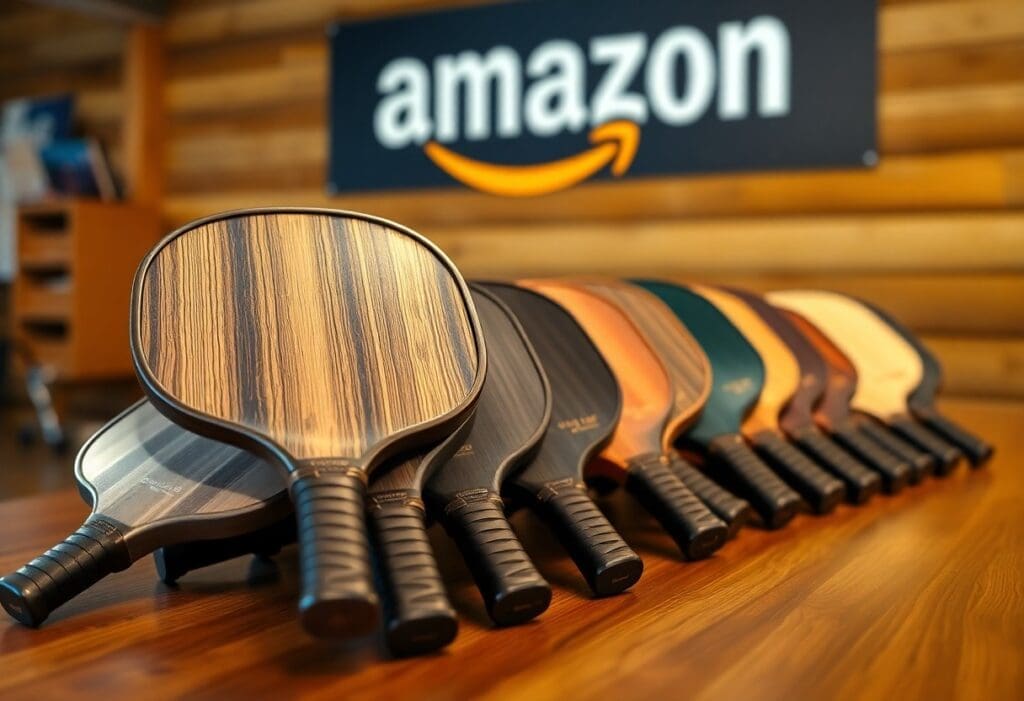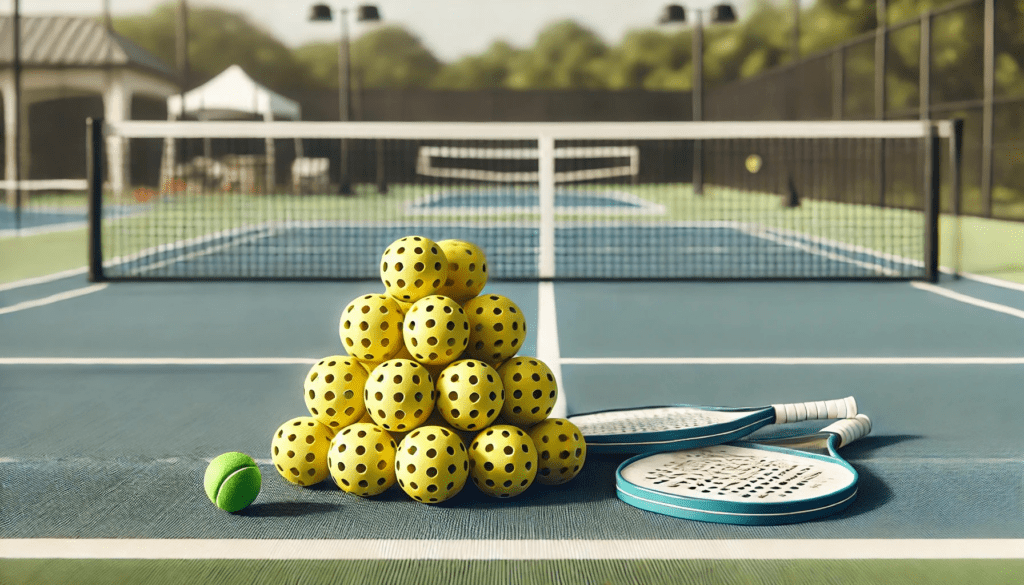You’re ready to hit the court and play some pickleball, but you’re not sure what’s going on when your opponent yells “Let!” or “Fault!”
You want to understand the game, but all the terminology is super confusing.
Don’t worry, you’re about to become a pickleball pro!
In this guide, you’ll learn the basic terms and rules of pickleball, so you can focus on having fun and improving your game.
Understanding Pickleball Terms
Before you step onto the court, it’s a good idea to familiarize yourself with the language of pickleball.
By knowing the terminology, you’ll will be able to understand the game, communicate with your partner, and even improve your gameplay.
Official Terminology
You’ll often hear players using phrases like “dink shot” or “kitchen” during a game.
To better understand the nuances of the game, it’s helpful to learn these common phrases and slang expressions.
You’ll want to understand all of the following terms before trotting out on the court to show your wares with Pickleball:
- Dink: A soft shot that is hit from the non-volley zone and lands just over the net in the opponent’s non-volley zone. It’s meant to keep the ball low and unattackable.
- Kitchen: The non-volley zone near the net where players are not allowed to hit volleys (balls hit out of the air without letting them bounce). It extends 7 feet from the net on both sides.
- Volley: A shot where the ball is hit before it bounces. You can only volley outside of the kitchen.
- Serve: The underhand stroke that starts each point. The ball must be hit diagonally across the court into the opposite service box.
- Third Shot Drop: A strategic, soft shot used by the serving team on the third shot of a rally, intended to land softly in the opponent’s kitchen. It helps neutralize an aggressive opponent.
- Baseline: The back boundary line at each end of the court, 22 feet from the net.
- Fault: Any action that stops play because of a rule violation, like hitting the ball out of bounds or stepping into the kitchen to volley the ball.
- Rally: The continuous back-and-forth play between players after the serve, until a point is scored or a fault occurs.
- Lob: A high, arcing shot meant to land deep in the opponent’s court, usually used to push back opponents who are at the net.
- Side Out: When the serving team loses its serve and the opponents take over. Only the serving team can score points in pickleball.
Basic Rules for Beginners
Here are the basic rules of pickleball:
1. The Court and Net
- The pickleball court is 20 feet wide and 44 feet long, with the net 36 inches high at the sidelines and 34 inches high in the middle.
- Each side of the court has a non-volley zone (also called the kitchen), extending 7 feet from the net.
2. Serving
- The serve must be made underhand, with the paddle contacting the ball below the server’s waist.
- The serve must be hit diagonally across the court, landing in the opponent’s service box (past the kitchen line).
- The server must stand behind the baseline and can only serve underhand. The ball must land in the service box of the opposite side.
- The serve starts on the right-hand side of the server and alternates between right and left after each point.
- The ball must clear the net and not land in the kitchen.
- The server gets one attempt, unless there’s a let (if the ball touches the net but lands in the service box, it is retaken).
3. Double Bounce Rule
- When the ball is served, the receiving team must let it bounce once before returning it. Then, the serving team must let it bounce once before playing it. After these two bounces, players can volley (hit the ball out of the air) or let it bounce before returning.
4. Scoring
- Only the serving team can score points.
- Games are typically played to 11 points, and a team must win by at least 2 points.
- Points are scored when the opponent commits a fault, such as hitting the ball out of bounds, into the net, or violating other rules.
5. Faults
A fault is any action that violates the rules, including:
- Hitting the ball out of bounds.
- The ball not clearing the net.
- Volleys hit from inside the non-volley zone (the kitchen).
- Volleying before the ball has bounced once on each side after the serve (violating the double bounce rule).
6. Non-Volley Zone (Kitchen)
- Players cannot volley the ball while standing in or touching the kitchen (the 7-foot area near the net on both sides).
- You can enter the kitchen to hit a ball, but only if the ball bounces first.
7. Doubles vs. Singles Play
- Doubles is the most common format of pickleball. In doubles, each player on a team gets a chance to serve before the other team serves. Only when both partners have lost their serves (except for the very first serve of the game) does the opposing team take over the serve.
- In singles, the same rules apply, but only one person serves per side.
8. Side Out
- A side out occurs when the serving team commits a fault, causing the serve to switch to the other team. In doubles, the serve rotates between partners, so both players on a team get to serve before the side out is called.
9. Changing Sides
- Teams switch sides of the court when one side reaches 6 points (in games to 11) to ensure fairness regarding any court advantages like wind or sun.
These are the core rules, but you’ll also encounter strategic nuances and more advanced rules as you play more frequently!
If you want to learn more about the rules, Pickleball USA has more for you to chew on.
Tips for Improving Your Game
For consistent improvement, focus on developing good habits and practicing regularly.
Here are some tips to help you take your game to the next level:
- Practice your serves and returns to build confidence and accuracy.
- Work on your footwork and court positioning to cover more ground.
- Analyze your opponents’ strengths and weaknesses to develop effective strategies.
The more you practice, the more comfortable you’ll become with the rules and the better you’ll be able to anticipate and react to different situations.
A Step-by-Step Guide to Playing Pickleball
After learning the basic rules and terms, it’s time to examine the gameplay. Here’s a breakdown of the steps to follow:
| Step | Action |
| 1 | Serve the ball by hitting it into the diagonally opposite service zone. |
| 2 | The opposing team returns the serve. |
| 3 | You and your partner hit the ball back and forth until one team fails to return it. |
| 4 | You score a point when the opposing team fails to return the ball. |
| 5 | The team with the most points at the end of the game wins. |
Pros and Cons of Playing Pickleball
Many people are drawn to pickleball because of its unique combination of social interaction, physical activity, and mental stimulation.
If you’re considering adding this to your list of hobbies, the following are the pros and cons you want to take into account before going full speed:
| Pros | Cons |
|---|---|
| Easy to learn | May be difficult to find courts or partners |
| Social benefits and community | Can be physically demanding |
| Improves hand-eye coordination and agility | May require significant investment in equipment |
| Low-impact exercise for joints | Can be frustrating for beginners |
| Improves mental focus and strategy | May lead to overexertion or burnout |
Pickleball Terms and Rules Demystified!
So there you have it, a sky-high overview of pickleball, including how to talk the talk AND walk the walk.
Of course, you need more than just knowledge to play. You’ll also need to get your hands on the right gear.
In our next pickleball post, we will run down all of the supplies you need to get into the game.
Until next time, enjoy our other hobby-related content!



